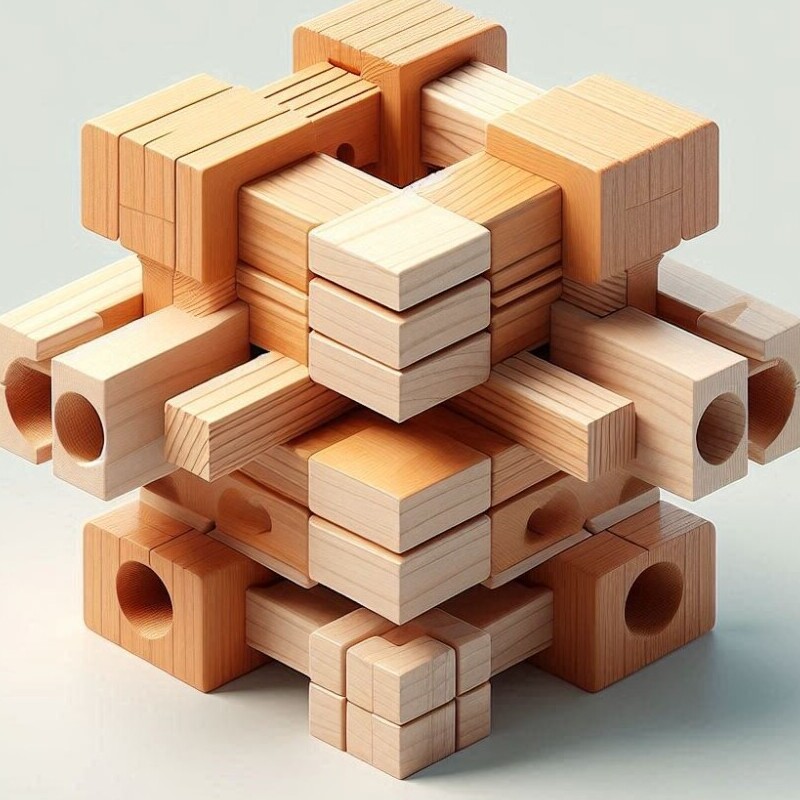
Wood joinery is all about connecting pieces of wood without the nuts, bolts, or any of that extra hardware. It’s been around forever and is still super important in pulling off a professional finish in your woodworking projects. What’s cool about joinery is how it combines functionality and sheer creativity, making every piece a unique statement.
Precision and artistry pretty much sum up why joinery’s so legendary. You really need that perfect fit, or your whole project could end up wobbling on one leg, or worse. The craftsmanship involved isn’t just about cutting and fitting; it’s like piecing together a puzzle where every part has to click just right.
Joinery’s got its roots way back in the day, with every culture adding its spin. Imagine someone using the same old-school techniques from centuries ago to craft your sleek modern table—talk about blending tradition with innovation! It’s not just about the old ways, though. Modern joinery has adopted fresh techniques and tools that barely make you break a sweat while doing the job just fine.
For anyone stepping into the woodworking scene, getting your head around these basics of joinery is like getting your license before jumping into the driver’s seat. Trust me, understanding how these joints come together will save you countless headaches down the path. Let’s get those hands a bit busy and see what works best for your style and what screams your name in the world of wood joinery.
Mortise and Tenon: Timeless Technique with Modern Applications
Mortise and tenon joints are one of those classics in woodworking that seems to never go out of style—even after all these years. It’s the joint that holds wooden structures together without screws, nails, or any of that modern fastener business. Just two pieces of wood seamlessly fitted together, simple yet incredibly effective for both structural integrity and aesthetic appeal.
These joints date back to ancient civilizations, used in everything from furniture to massive edifices. In basic terms, a mortise and tenon consists of one piece with a protruding ‘tenon’ carved at the end, which slots neatly into a corresponding hole or ‘mortise’ on the other piece. This creates a snug fit that stands up against twisting or pulling forces.
Variations of mortise and tenon joints include through and blind types, each with its place in specific applications. Through tenons go all the way through the other piece of wood, visible on the other side while blind tenons stop within the wood, hidden from view. You might even come across the wedged version, adding extra flair and strength by driving little wedges into the tenon.
Incorporating mortise and tenon into your works isn’t just a nod to tradition but a practical solution for ensuring long-lasting durability. You’ll typically find these joints in tabletops and chair frames where stability is critical. While they might look a bit daunting to a newbie, with the right tools and some patience, you’ll master this timeless joint before you know it.
Modern twists on this ancient joint make it accessible even to beginners. Innovations like power tools or joinery jigs can save tons of time in crafting those perfect fits. If you’re new, start with some practice pieces to get a feel for the chiseling and remember—precision is key! Just a fraction off, and you could be stuck with a wobbly mess instead of a masterpiece. But with practice? The satisfaction of seeing those snug, tight fits is one for the books.
Dovetail Joints: Marrying Strength and Aesthetic
Dovetail joints are where strength meets beauty in woodworking. These joints are not only super sturdy, but they’re also kinda like the badge of honor for woodworkers, showing off just how skilled you are. You’ve got overlapping ‘tails’ and ‘pins’ that fit together tight enough to stay strong without needing a single nail or screw.
The dovetail’s been a favorite for ages, found in everything from ancient Egyptian furniture to sleek modern cabinetry. It’s got this timeless look that screams craftsmanship. A lot of the reason it’s so loved is the interlocking design, which resists pulling apart, making it great for drawers and boxes that need to hold up to stress.
There are a few variations to know about, such as the through dovetail, which shows off the end grain on both pieces of wood and really flaunts that intricate pattern. Then there’s the half-blind dovetail, mostly hidden from view, which gives you a neat and clean front face. For those really wanting a stealthy look, there’s secret dovetail, perfect for keeping that joint under wraps.
Mastering dovetail joinery takes a bit of practice, especially getting those angles just right so everything locks together seamlessly. A good way to start is practicing with softwoods before jumping onto the fancy hardwoods. And never underestimate the power of a good marking gauge and a sharp chisel in your toolkit!
These days, even if you’re not chiseling everything by hand, there are plenty of guides and router jigs out there to help you get perfect joints without hours of fretting over each cut. Working on dovetails can turn your projects not just into pieces of furniture, but into works of art that tell a story of dedication and skill.
So if you’re thinking of adding a touch of elegance and durability to your next build, dovetail joints might just be what you’re looking for. Sure, they take some effort to master, but once you get the hang of them, they’ll make your works stand out with a touch of classic charm.
Beyond the Basics: Exploring Exotic Wood Joinery Techniques
When it comes to joinery, there’s a whole world beyond the common joints that can really take your woodworking up a notch. Let’s talk about some of those less-famous techniques that might just surprise you with their flexibility and flair in design.
One such technique is the finger joint, which gets its name from the way it looks like interlocking fingers. It’s kind of like the cousin of the dovetail, often used in long pieces for added length and strength. Box joints are another go-to for straightforward yet strong connections, perfect for building drawers and boxes on a budget without sacrificing durability.
Then there are Japanese joinery methods, which are kind of legendary for their complexity and elegance. Techniques like Kumiko and Shiguchi can turn a simple project into a work of art, adding unique, intricate patterns that are visually stunning and structurally sound. These cutting-edge joints often don’t even need glue, relying on the impeccable fit of the pieces instead.
Understanding which joinery method to use often comes down to the type of wood you’re dealing with. Softer woods might not hold up well with finer joints or intricate Japanese techniques, while hard woods can really show off those meticulous cuts and fits. Each type of joint brings its character to the final product, making it essential to tailor your approach to your materials.
Experimenting with these exotic techniques adds that extra level of craftsmanship to your projects. While they might seem intimidating at first, with the right tools and a bit of patience, they’re definitely within your reach. The payoff is in creating unique pieces that can leave a lasting impression, showcasing your skill and pushing the boundaries of traditional woodworking methods.
Combining Functionality and Beauty: Decorative Joinery Techniques
Decorative joinery techniques turn ordinary woodworking projects into visually stunning pieces. It’s about adding those little artistic touches that elevate every piece and catch the eye, blending function with flair.
Aesthetics matter in woodworking. Even something as basic as a wedge or peg can transform a wooden assembly into a focal point of design. Highlights like exposed tenons or fancy pegs not only add robustness but also give your work a handmade, custom feel that can’t be rivaled.
Getting creative with decorative techniques doesn’t always require advanced skills. Start with simple touches like chamfering edges or cutting elegant curves alongside the joints. Creating embellishments that are both practical and decorative lets your personality shine through in your work’s final look.
Looking for inspiration? Dive into case studies of furniture and architecture that mastered the art of decorative joinery. These examples showcase how thoughtful, artistic design can redefine spaces or even reinvent everyday objects into a statement piece loaded with character.
Don’t shy away from taking bold design risks in your joinery projects. Add personalized patterns, experiment with color stains, and use contrasting wood types to further emphasize the joint details. Decorative joinery is your chance to go beyond utility and make your projects truly unforgettable.
Exploring these techniques doesn’t just add new skills to your toolkit; it’s about expressing yourself through every joint and curve, leaving a unique mark on every woodworking creation you present to the world.
Choosing the Right Technique: Factors to Consider in Wood Joinery
Choosing the right joinery technique can make or break your woodworking project, so it’s key to weigh a few crucial factors before getting started. Picking the perfect method involves considering the wood, the project size, and its ultimate purpose.
Each type of wood has its quirks. Softwoods can be more forgiving, but they might not handle intricate joints well. Hardwoods, on the other hand, can really highlight fine joinery. Think about how each wood type can affect not just the look but also the durability of your finished piece.
Size matters too. Smaller pieces might need precision joinery to maintain stability without bulking up the structure. For larger projects, go for techniques that ensure structural integrity even when under load. A joint that’s perfect for a small box might not be the best choice for a sprawling table design.
Keep in mind the environment where your piece will live. Changes in humidity and temperature can cause wood to expand or contract. Choose joints that can flex with these changes if your creation’s home will go through lots of seasonal shifts, helping prevent warping or cracking over time.
If you’re just starting out, focus on mastering a few basic but versatile joints. They’re often the building blocks for more complex techniques, and getting them under your belt can offer a solid foundation for your skills. Stock up on essential tools like chisels, saws, and clamps to handle these tasks with efficiency.
Incorporating these joinery tips brings a level of craftsmanship and longevity to your work that you can be proud of, and this careful consideration helps ensure your projects are as functional as they are beautiful.
Attached is a you tube video on unique joinery:


